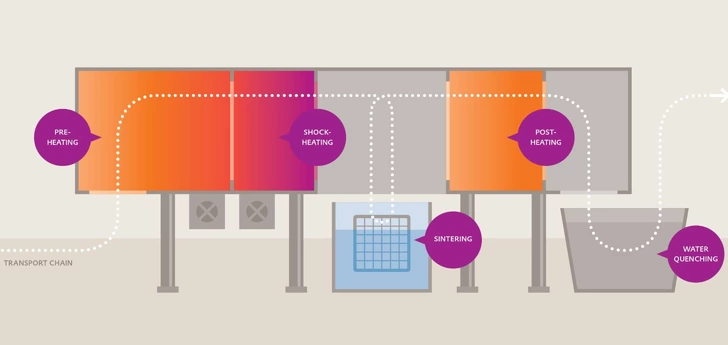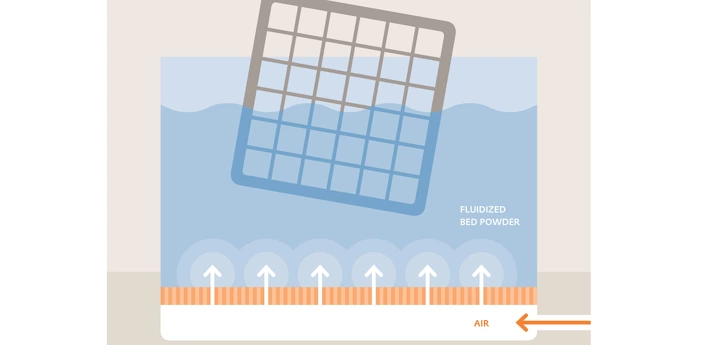
VESTOSINT® FOR DEMANDING COATING APPLICATIONS
POLYAMIDE 12 POWDERS
VESTOSINT® stands for high-performance powders manufactured by a special
physical process and features a nearly round geometry. Therefore, they are eminently suited particularly for coatings.
Evonik manufactures laurolactam, the monomer of polyamide 12 (PA 12), derived from butadiene. Polyamide 12 has the lowest amide group concentration of all commercially available polyamides, allowing for lower moisture absorption and maintenance of mechanical stability while under conditions of changing humidity.
PROPERTIES of VESTOSINT® POLYAMIDE 12 POWDERS
PA12 powders offer similar superior property characteristics as PA12 granules, which includes:
- high toughness
- very good resistance to greases, oils, fuels, hydraulic fluids, water, alkalis, saline solutions and many organic solvents
- very good stress crack resistance, even when exposed to chemicals
- low coefficient of sliding friction and high abrasion resistance even when running dry
- noise and vibration dampening

The coating powder manufactured from the base polymers with technically challenging processes affords other physical, chemical and electrical properties that make it perfect for a broad spectrum of applications:
- high mechanical strength, elasticity and surface hardness
- low water absorption and water vapor permeability
- high resistance even in warm and detergent-containing water
- low thermal conductivity
- good electrical insulation and dielectric strength
- easy to clean
- no surface fouling
VESTOSINT® maintains these properties even at extreme sub-freezing temperatures. VESTOSINT® coated objects are not only protected from abrasion, scratching and impact abuse but also, from chemicals and corrosion. The protective action increases pro- portionally to the layer thickness, up to 500 microns.
Applications of VESTOSINT® POLYAMIDE 12 POWDERS

The high impact strength and abrasion resistance favor the high-performance polymer powder VESTOSINT® for use in the automobile industry. Example application include automobile hood props, seat belt anchors, springs and latches. High stress components such as safety belt holders acquire their major safety feature only as a result of the VESTOSINT® coating. It covers the metal edge of the component, thus protecting the belt from cuts in emergencies.

Thanks to the optimized particle size distribution of the powders, a non-porous coating is ensured on wire products such as dishwasher racks, shopping carts and furniture. The high resistance of VESTOSINT® coatings to hot, rinsing agent containing water and its elasticity are of prime importance for dishwasher racks. Therefore, the dishes are pre- served and protected during wash and rinse cycles. In addition, the coating absorbs impact and noise while pro- viding abrasion resistance and long term reliability.

VESTOSINT® powders are used for medical applications due to the smooth surface which prevents bacteria growth. In addition, VESTOSINT® coated parts may be sterilized.

Plastic coatings have long been used with success in pipelines and fittings. The protective layer applied by the fluidized bed coating process resists high corrosive stresses. Mechanical strength; elasticity, even at low temperatures; good resistance to chemical; and corrosion resistance are key requirements for pipes and fittings. VESTOSINT® PA12 powder coatings may also be used for cooling water lines; in naval construction and plant and power plant lines due to the property charac- teristics.

Other industrial applications such as printing rollers, gasoline pump levers, hydraulic cylinders or hanging file holder rods benefit in particular from the chemical resistance, wear resistance and abrasion resistance of VESTOSINT® coating powders.


Processing of VESTOSINT® POLYAMIDE 12 POWDERS
Fluidized Bed Coating Process

When metals are coated with polyamides, the positive properties of the two materials are combined. Fluidized bed coating technology is the most cost-effective method for coating preheated, preferably metallic objects with plastics. It consists of a combination of fluidized bed and immersion processes.
With an economical equipment investment, layer thicknesses of 250 - 500 microns are achieved; even coatings of 1 - 2 millimeters are possible. A fluidized bed coating pan consists of the powder container and the air receiver, separated by a porous fluidizing bottom. Oil- and dust-free air flows into the air receiver and passes through the fluidizing bottom in the form of fine bubbles. It transforms the sintering powder to the fluidized state resembling boiling liquid.
The fluidized bed coating powder has a particle size distribution ranging from 30 to 250 microns and is adjusted so as not to produce dust. Metal substrates of any geometry constructed of steel, metal alloys or aluminum can be coated. To do this, dip the pieces in fluidized VESTOSINT® powder. The powder sinters to the surface of the substrate and fuses into a smooth surface thanks to its residual heat. De- pending on the desired coating thickness, the pieces are heated to 230 - 450 °C and dipped for 2 - 10 seconds. The process operates without solvent. Materials that change their shape, lose their properties or generate gases during the above described procedure cannot be coated.
Minicoating process

The main fields of application of minicoating includes the coating of clips for the undergarment industry and component coating for the electric and automobile industries. The principle of minicoating is similar to that of fluidized bed coating. Hot (small) parts drop into a fluidized VESTOSINT® powder pan. As they fall, the powder sinters to the metallic surface. Subsequently, the objects are conveyed out of the VESTOSINT® container in a vibrating trough and the surface is further smoothed, no matter the shape of the articles being coated.
Warm spraying
Warm spraying is also possible on demand.



